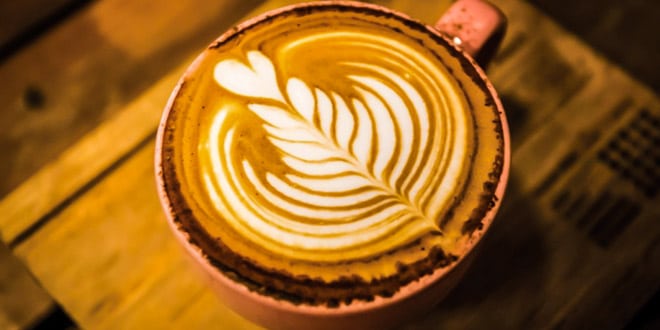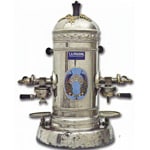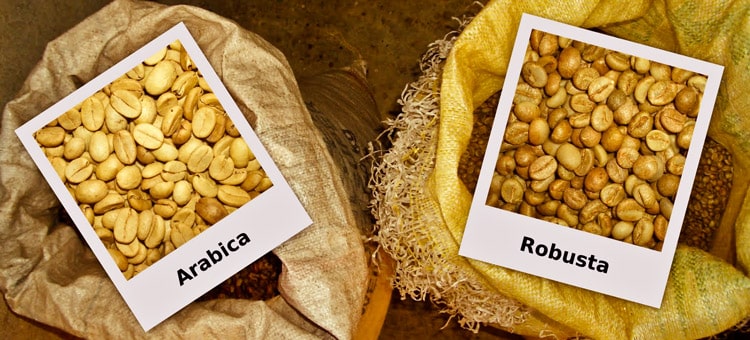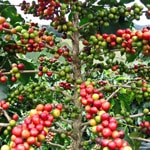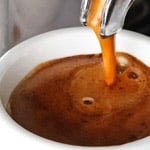Currently, the word “coffee” refers to a drink, usually hot, obtained by brewing the ground beans of the coffee tree. In a literal translation from Arabic, the name “coffee” sounds like “an exciting drink.”
Indeed, after consuming the drink, a solid stimulating effect is felt, thanks to the caffeine it contains.
Today, the true magic of this drink, with its enchanting aroma, can be experienced by visiting Italy. There, coffee has become an integral part of national cuisine, inseparable from pizza, pasta, and olive oil. Visiting Italy, you can try at least one of the many coffee options served in Italian bars. Trying this rich, strong drink in its pure form or with additions like milk foam, ice cream, liqueur, or lemon will let you rediscover all its taste nuances.
Page Contents
Origin
It’s challenging to say for sure when and who discovered coffee. One of the origin stories traces back to 900 BC.
According to legend, an Ethiopian shepherd noticed his goats becoming very active after eating red berries from a tree. Trying these berries, the shepherd felt his body fill with strength and energy. 
Since then, the coffee tree’s fruits have been processed in various ways. The beans were dried, boiled, crushed, and used to make tinctures, all for the energizing effect of the coffee beans. Over time, the Ethiopian lands were occupied by Arabs, and the new inhabitants adopted the habit of consuming this energizing product. They ground the raw beans, mixed them with fat, and formed balls, which were very convenient for travel. The raw fruits of the coffee tree are small nuts containing caffeine, making the ground product both nourishing and invigorating for travelers during long journeys.
It took many centuries for the experiments with coffee beans to evolve into initial cleaning, subsequent roasting, and grinding for brewing the resulting powder. 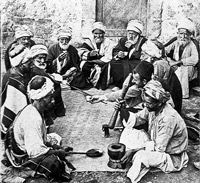
By the mid-15th century, coffee reached the territory of Turkey. It was so well-liked by the Eastern inhabitants that church officials had to curse coffee in the prophet’s name. They observed that believers started spending more time in coffee houses than prayer. However, the church’s hostility toward coffee eventually diminished.
With the widespread distribution of coffee came the art of its preparation. Places where coffee was made publicly began to emerge everywhere. Coffee houses became meeting spots, with coffee as a reason for pleasant social interaction. The concept of coffee houses gradually moved to Europe, and their inner world is reflected in modern cafés.
The History of Espresso
Lately, going to cafes and drinking coffee has become fashionable, almost like a lifestyle. Inviting friends to a cafe for a cup of coffee rather than to one’s home. When ordering a classic espresso, we hardly think about the fact that this brewing method was invented in Italy and then spread worldwide. Today, residents of America, Europe, the Middle East, and Asia prefer this type of coffee.
The first espresso machine was introduced in Italy in 1905. Its operation was based on passing water, condensed from steam, through ground coffee under pressure. The taste of the resulting coffee was fundamentally different from today’s beverage. Due to excessive overheating, the coffee acquired a burnt taste. Initially, this coffee was consumed by the bourgeoisie, and later, the brewing method spread to Germany and France.
In the mid-20th century, a significant change occurred in the approach to coffee preparation. Steam was removed from the espresso machine. Instead, water was heated to no more than 92 degrees Celsius (197.6 degrees Fahrenheit) and passed through coffee under high pressure. That’s when the taste of espresso, as we know it today, appeared. Machines gradually improved, and now espresso is made very quickly, with precise temperature control.
Types of Coffee Trees
About 200 varieties of coffee trees worldwide, but only 20% are utilized by humans. Only two main types of coffee connoisseurs are interested in: Arabica (Coffea Arabica), known as Arabian, and Robusta (Coffea Canephora), known as Congolese. 90% of the coffee consumed is produced from the fruits of these tree species.
Arabica
The Arabian coffee tree is considered the most popular type of coffee tree. 70% of the world’s coffee is produced from its fruits.
Naturally, this tree reaches 6-8 meters in height, but for an easier harvest, it’s kept below 4 meters.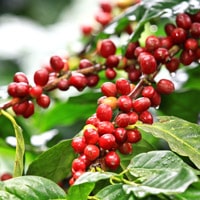
Arabica beans contain 18% aromatic oils and about 1.5% caffeine. The taste of Arabica in the finished drink is sweetish with a slight acidity. The best varieties of Arabica are considered to be Bourbon, Maragogipe, and Typica.
Robusta
The height of the Canephora tree, or simply Robusta, can reach up to 10 meters in nature. However, when cultivated en masse, it is pruned and shaped into smaller trees. Robusta flowers are gently pink, while the fruits are greenish or brownish-gray.
This tree was first discovered in the Congo River basin in Africa. Today, Robusta trees are grown in both Africa and Asia, predominantly on flat plantations. The plant is quite unpretentious in care, tolerates temperature fluctuations well, and is resistant to diseases and pests. Up to 15 harvests can be collected from a Robusta coffee plantation per year. Due to its low maintenance and high yield, cultivating Robusta is very profitable.
Robusta fruits contain 8% aromatic oils and up to 3.5% caffeine. The taste of this coffee type is quite specific and strong. Therefore, it is often used to add strength to coffee blends. Robusta’s flavor also improves when making instant coffee. Despite its lower taste qualities compared to Arabica, Robusta makes up 30% of all coffee produced.
Arabica and Robusta, in turn, are divided into many varieties depending on their region of origin. All varieties differ from each other in taste and aromatic properties.
Besides varieties, coffee is also classified by the quality of the beans obtained. For example, SHG refers to coffee from mountainous regions, HG to coffee from foothills, MG or CS to coffee from flat plantations, HB to hard bean coffee, A to high-quality coffee, B to medium quality coffee, C to low-quality coffee, AA to best, AB to good, BA to average, and BB to low quality.
Coffee Preparation and Consumption Culture
In Italy, coffee is so beloved and consumed in such quantities that many preparation methods have been invented. Italians make coffee for breakfast, during or after breaks, and after meals, along with dessert.
Espresso, also called “normale” (from “normale” – standard), is considered the classic type of coffee. What is served in Russia and former Soviet countries as espresso often significantly differs from its Italian counterpart.
Italian espresso is velvety thick foam with a golden hue covering the entire surface of the coffee in the cup, a soft aroma filling the room and making you forget about everything else. The perfect, balanced, pronounced taste of authentic Italian espresso is indescribable.
According to coffee etiquette, espresso is served in a porcelain cup with thick walls shaped like a truncated ellipse. The standard volume of such a cup is 75 ml, but the content, depending on the type of coffee, should occupy 25 to 50 ml. This presentation maximally reveals the coffee’s flavor and aroma. In bars, coffee brewing is handled by a specialized master called a barista.
Types
The most popular type of coffee is undoubtedly espresso. Its reduced variant – ristretto – is a standard portion of ground coffee but in a volume of one sip, i.e., 20 ml. This coffee contains more aroma and less caffeine compared to its classic counterpart.
Lungo
Lungo is an espresso diluted with hot water to double its volume. This coffee contains more caffeine because the water passes through the ground coffee longer.
Cappuccino
Cappuccino is espresso with a large amount of milk foam reaching the edge of the cup. 
Americano
Americano is a full pot of coffee (up to 470 ml) made from one portion of ground coffee. Italians call such coffee acqua sporca, meaning “dirty water.” The true American way of brewing is to use a filter coffee maker. In Europe, however, brewing Americano has changed, and classic espresso is diluted with hot water to a volume of 120 ml.
Latte
Latte is one of the coffee with milk variations. It’s essentially milk with a bit of milk foam diluted with a small amount of coffee. The coffee is poured into heated milk in a skinny stream, not vice versa. It’s served in a tall, transparent glass of 200 ml.
Mocha or Mochaccino
Mocha or Mochaccino is a variation of latte. In this case, one-third of the drink is espresso, and the remaining two-thirds are hot chocolate, milk, and whipped cream. Delicious.
Macchiato
Macchiato is espresso with a small amount of milk. It’s also called marbled or stained coffee.
Corretto
Corretto is coffee for those who find coffee not strong enough, and then a portion of alcohol is added to espresso. It could be whiskey, grappa, or liqueur. Depending on the type of alcohol, the possible origin of the recipe can be determined.
- Coffee with whiskey is Irish coffee;
- with vodka is Russian coffee;
- with gin is English coffee;
- with schnapps is German coffee.
Classic Italian is considered coffee with a dash of amaretto.
Glace
Glace is a serving of espresso topped with ice cream. The coffee is cooled to about 10 degrees Celsius (50 degrees Fahrenheit) before adding the ice cream, constituting a quarter of the total volume. Chocolate, cinnamon, and caramel can be used as additional toppings.
Romano
Romano is an espresso with a small amount of lemon juice added.
Which Coffee is the Best
Despite the widespread myth that Italy produces the best coffee in the world, it may be disappointing to learn that coffee is not produced in Italy. Due to climatic conditions, coffee trees are not grown in this country. 
Many companies in the country roast coffee. Almost each produces beans of good quality, suitable for use in espresso machines and home coffee makers. Italians believe that coffee should be accessible as well as of good quality. Therefore, coffee, including for export, is prepared so that the resulting espresso is of above-average quality.
Every region in Italy has its favorite coffee bean supplier. Next to the signs of bars, you usually find a logo indicating the coffee brand served in that establishment. Large retail chains also strive to sell roasted coffee beans under their own brand.
The best-known Italian coffee brands are deservedly Lavazza, Illy, Cartapani, and Trombetta. The Illy brand belongs to the Illy family from Trieste, while Lavazza was founded in 1895 as a small family business by Luigi Lavazza. In the 18th century, nobody could have imagined that this family business would become a sales leader in dozens of countries worldwide two hundred years later. Today, this company’s offices are located in the capitals of many countries around the world.
Despite such loud success and widespread popularity, the Lavazza family continues to carefully preserve the recipes and knowledge bequeathed by their founder, their great-grandfather. The company controls the coffee-making processes, from harvesting the fruits to roasting and grinding.
Dessert with Coffee
The traditional Italian dessert served with coffee is tiramisu. Although this delicious dessert is prepared worldwide today, it was born in Italy. The words that come to mind when thinking of tiramisu are delicate cheese, airy biscuits, dark chocolate, and coffee—real, hot, thick, aromatic with a slight bitterness.

The biscuit fingers are soaked in a mixture of strong black coffee and alcohol. The alcohol can be cognac, brandy, or a liqueur, such as coffee liqueur. The soaked biscuits are layered with delicious cheese, and the top is sprinkled with dark-grated chocolate. The strong beverages should be omitted from the recipe if the dessert is to be served to children.
The only drawback of this divine dessert is its high caloric content. So, those prone to gaining weight should probably not indulge in tiramisu too much. However, trying a small piece is definitely a must.
How to Properly Prepare Coffee

Home Coffee Brewing Recipe from Italy4.me
There are incredibly many ways to prepare coffee at home: some use a cezve, some have equipped their kitchen with an espresso machine, and others use the good old Moka pot. By the way, the Moka pot (or caffettiera) is based on the principle of the first espresso machine we mentioned at the beginning of the article.
So, let’s move directly to the recipe.
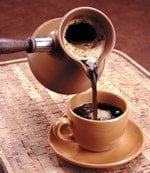 Those who like strong coffee can add a bit more, but I advise not to exceed two spoons per serving, as too much caffeine can affect the taste. If you prefer coffee with sugar, adding it at the beginning of brewing is recommended, not after the beverage is served. There’s a noticeable difference, though the secret is unclear.
Those who like strong coffee can add a bit more, but I advise not to exceed two spoons per serving, as too much caffeine can affect the taste. If you prefer coffee with sugar, adding it at the beginning of brewing is recommended, not after the beverage is served. There’s a noticeable difference, though the secret is unclear.
Finally, pour water over it and set it on medium heat. A gently golden foam will start forming on the surface. When it begins to rise, remove the Cezve from the heat. Never let the coffee boil!
It’s best to serve the Cezve at the table, letting everyone pour their own coffee. This way, it won’t cool down, as reheated brewed coffee is not advisable.
 Italy for me From Italy with love
Italy for me From Italy with love

